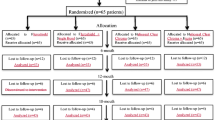Abstract
AIM: This was to evaluate the retention rate of fissure sealants applied to MIH molars with occlusal enamel opacities, using two different application methods after 4 years. METHODS: 54 children exhibiting molars with MIH aged 6–7 years, participated in the study. Selection criteria: presence of at least 2 fully erupted caries-free maxillary or mandibular first permanent molars in the opposite sides of the mouth, both with occlusal enamel opacities without breakdown. Following parental consent, sealants were applied using a half-mouth experimental design. Group A: On a randomly assigned first molar on one side of the mouth sealants (Fissurit®) were placed using a single bottle adhesive system (One-step®) prior to sealant application. Group B: Sealants were applied on the contra-lateral molar using the conventional etch and seal technique. Children were seen biannually when a preventive program was applied, without replacing any lost sealant. RESULTS: After 4 years, 47 sets of molars (94 teeth) were available for blind evaluation. Teeth in Group A presented a better retention rate; 70.2% were fully sealed, 29.7% partly sealed and none unsealed (lost sealant). Group B revealed 25.5% fully sealed, 44.6% partly sealed and 29.7% unsealed teeth. STATISTICS: Differences between groups A and B were statistically significant (p<0.001). Also both groups revealed a decreasing retention rate over the 4-year period (p<0.001). There was no difference in dental caries increment rate and enamel breakdowns at the end of the study (p>0.01). CONCLUSIONS: In hypomineralised molars with occlusal opacities sealants appear to have greater retention when applied using 5th generation adhesive systems prior to sealant.
Similar content being viewed by others
References
Beauchamp J, Caufield PW, Crall JJ, et al. Evidence-based clinical recommendations for the use of pit-and-fissure sealants. A report of the American Dental Association Council on Scientific Affairs. J Am Dent Assoc. 2008; 139:257–268.
Burbridge L, Nugent Z, Deery C. A randomized controlled trial of the effectiveness of a one step conditioning agent in sealant placement: 6-month results. Int J Paediatr Dent. 2006; 16(6):424–30.
Chawla N, Messer LB, Silva M. Clinical Studies on Molar-Incisor-Hypomineralisation Part 1: Distribution and Putative Associations. Eur Archs Paediatr Dent. 2008; 9(4):180–190.
Fayle SA. Molar incisor hypomineralisation: restorative management. Eur J Paediatr Dent. 2003; 4:121–126.
Feigal RJ, Musherure P, Gillespie B, et al. Improved sealant retention with bonding agents: a clinical study of two-bottle and single-bottle systems. J Dent Res. 2000; 79(11):1850–1856.
Feigal RJ, Donly KJ:, The Use of Pit and Fissure Sealants. Pediatr Dent. 2006; 28:143–150.
Gomes-Silva JM, Torres CP, Contente M, et al. Bond Strength of a Pit-and-Fissure Sealant Associated to Etch-and-Rinse and Self-Etching Adhesive Systems to Saliva-Contaminated Enamel: Individual vs. Simultaneous Light Curing. Braz Dent J. 2008; 19(4):341–347.
Heijs S.C.B, Dietz W, Noren J.G, Blanksma N.G, Jalevik B. Morhology and chemical composition of dentin in permanent first molars with the diagnose MIH. Swed Dent J. 2007; 31:155–164.
Jälevik B, Noren JG. Enamel hypomineralization of permanent first molars: a morphological study and survey of possible aetiological factors. Int J Paediatr Dent. 2000; 10:278–289.
Jasulaityte L, Veerkamp JS, Weerheijm KL. Molar incisor hypomineralization: review and prevalence data from a study of primary school children in Kaunas (Lithuania). Eur Archs Paediatr Dent. 2007; 8(2):87–94.
Kotsanos N, Kaklamanos EG, Arapostathis K. Treatment management of first permanent molars in children with Molar-Incisor Hypomineralisation. Eur J Paediatr Dent. 2005; 6(4):179–84.
Loguercio AD., Reis A. Application of a Dental Adhesive Using the Self-Etch and Etch-and-Rinse Approaches: An 18-Month Clinical Evaluation. J Am Dent Assoc. 2008;139;53–61.
Lygidakis NA, Chaliasou A, Siounas G. Evaluation of composite restorations in hypomineralised permanent molars: a four years clinical study. Eur J Paediatr Dent. 2003; 4(3):143–8.
Lygidakis N.A., Oulis C.I., Christodoulidis A. Evaluation of fissure sealant retention following 4 different isolation and surface preparation techniques. Four years clinical trial. J Clin Pediat Dent. 1994; 19(1):23–25.
Lygidakis NA, Dimou G, Briseniou E. Molar-Incisor-Hypomineralisation (MIH). Retrospective clinical study in Greek children. I. Prevalence and defect characteristics. Eur Archs Paediatr Dent. 2008a; 9(4):200–6.
Lygidakis NA, Dimou G, Marinou D. Molar-Incisor-Hypomineralisation (MIH). A retrospective clinical study in Greek children. II. Possible medical aetiological factors. Eur Archs Paediatr Dent. 2008b; 9(4):207–17.
Marthu-Muju K, Wright TJ. Diagnosis and Treatment of Molar Incisor Hypomineralization. Compedium 2006; 27(11):604–611.
Muller-Bolla M, Lupi-Pégurier L, Tardieu C, Velly AM, Antomarchi C. Retention of resin-based pit and fissure sealants: a systematic review. Community Dent Oral Epidemiol. 2006; 34:321–36.
Papacchini F, Goracci C, Sadek FT, Monticelli F, Garcia-Godoy F, Ferrari M. Microtensile bond strength to ground enamel by glass-ionomers, resinmodified glass-ionomers, and resin composites used as pit and fissure sealants. J Dent. 2005; 33(6):459–67.
Shapira J, Eidelman E. Six-year clinical evaluation of fissure sealants placed after mechanical preparation: a matched pair study. Pediatr Dent. 1986; 8(3):204–5.
Welbury R., Raadal M., Lygidakis NA. EAPD guidelines for the use of pit and fissure sealants. Eur J Paediatr Dent. 2004; 5(3):179–84.
William V, Burrow MF, Palamara JE, Messer L. Microshear bond strength of resin composite to teeth affected by molar hypomineralisation using 2 adhesive systems. Pediatr Dent. 2006; 28:233–241.
Willmott NS, Bryan RA, Duggal MS. Molar-incisor-hypomineralisation: a literature review. Eur Archs Paediatr Dent. 2008; 9(4):172–9.
Author information
Authors and Affiliations
Corresponding author
Rights and permissions
About this article
Cite this article
Lygidakis, N.A., Dimou, G. & Stamataki, E. Retention of fissure sealants using two different methods of application in teeth with hypomineralised molars (MIH): A 4 year clinical study . Eur Arch Paediatr Dent 10, 223–226 (2009). https://doi.org/10.1007/BF03262686
Published:
Issue Date:
DOI: https://doi.org/10.1007/BF03262686




